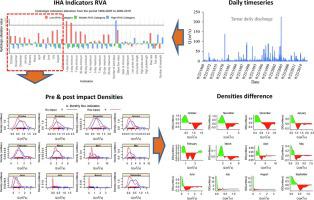Journal of Hydrology ( IF 5.9 ) Pub Date : 2022-09-24 , DOI: 10.1016/j.jhydrol.2022.128450 Vahedberdi Sheikh , Amir Sadoddin , Ali Najafinejad , Arash Zare , Arashk Hollisaz , Hamid Siroosi , Maryam Tajiki , Mostafa Gholipouri , Javad Sheikh

|
Assessing the natural or man-made alterations in the hydrological characteristics of watershed systems is a prerequisite to develop watershed management, restoration, and conservation strategies and plans. The Range of Variability Approach (RVA), based on a suite of Indicators of Hydrologic Alteration (IHA), is most widely used to assess hydrologic alterations. However, the traditional RVA and its revised versions and alternatives all suffer from major challenges such as binning the data and using only the target range to compare the probability distributions of the hydrologic variables in the pre- and post-impact periods through applying simplified statistical analyses. This paper proposes the Density Difference Approach (DDA) and the weighted RVA to overcome these challenges. Despite the previous approaches, which divide the time series of the continuous variables into discrete groups, DDA uses the continuous probability density function (pdf) estimated by the Gaussian Kernel Density Estimation (KDE) technique. It considers the magnitude, frequency, and order position of all individual data in the alteration analysis. Furthermore, to account for the variations in the values and frequencies of the variables beyond the target range, which is neglected in the traditional RVA, the weighted RVA approach has been proposed. These suggested approaches, along the other widely used alteration assessment approaches, have been applied to quantify the hydrologic alteration in the Gharnaveh watershed in the northeast of Iran using 50 years of daily discharge data recorded at the Tamar hydrometry station at the outlet of the watershed. The performance of the alteration analysis approaches was further evaluated using the randomly generated time series with the arbitrary changes in the probability distribution parameters. The results indicate a significant difference in the alteration values and ranks calculated by different alteration analysis approaches. Compared to the traditional RVA, the weighted RVA resulted in higher alteration degrees for most of the IHA indicators. DDA outperformed the other alteration analysis approaches for both the observed and randomly generated data. It better accounted for the alteration in the key characteristics of the probability distribution (including the location, dispersion, and skewness parameters) of the randomly generated data series. We recommend DDA as an appropriate hydrologic alteration assessment approach that assists water resource managers and decision-makers through accounting for multi-dimensional attributes of hydrologic alterations.
中文翻译:

用于评估水文状况变化的密度差和加权 RVA 方法
评估流域系统水文特征的自然或人为变化是制定流域管理、恢复和保护战略和计划的先决条件。基于一套水文变化指标 (IHA) 的变异范围法 (RVA) 最广泛用于评估水文变化。然而,传统的 RVA 及其修订版本和替代方案都面临着重大挑战,例如数据分箱和仅使用目标范围通过应用简化的统计分析来比较冲击前后水文变量的概率分布. 本文提出了密度差法 (DDA) 和加权 RVA 来克服这些挑战。尽管有以前的方法,将连续变量的时间序列划分为离散组,DDA 使用通过高斯核密度估计 (KDE) 技术估计的连续概率密度函数 (pdf)。它考虑了变更分析中所有单个数据的幅度、频率和顺序位置。此外,为了解决在传统 RVA 中被忽略的变量值和频率的变化超出目标范围,提出了加权 RVA 方法。这些建议的方法以及其他广泛使用的改变评估方法已被应用于量化伊朗东北部 Gharnaveh 流域的水文改变,使用流域出口处 Tamar 水文测量站记录的 50 年每日流量数据。使用随机生成的时间序列以及概率分布参数的任意变化进一步评估了变更分析方法的性能。结果表明,通过不同的蚀变分析方法计算出的蚀变值和等级存在显着差异。与传统的 RVA 相比,加权 RVA 导致大部分 IHA 指标的变化程度更高。对于观察到的和随机生成的数据,DDA 优于其他变更分析方法。它更好地解释了随机生成的数据序列的概率分布(包括位置、分散和偏度参数)的关键特征的变化。











































 京公网安备 11010802027423号
京公网安备 11010802027423号